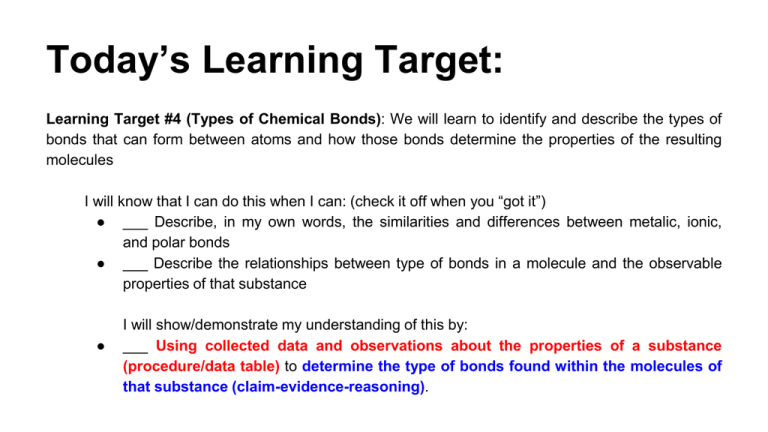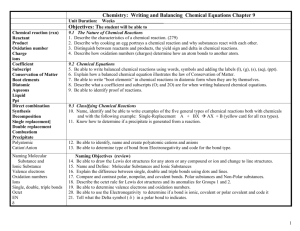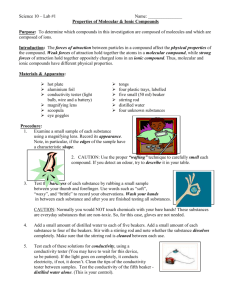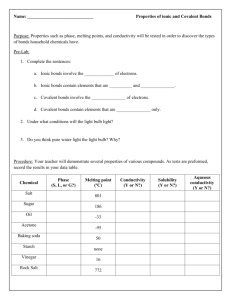Bonding LAB PPT
advertisement

Today’s Learning Target: Learning Target #4 (Types of Chemical Bonds): We will learn to identify and describe the types of bonds that can form between atoms and how those bonds determine the properties of the resulting molecules I will know that I can do this when I can: (check it off when you “got it”) ● ___ Describe, in my own words, the similarities and differences between metalic, ionic, and polar bonds ● ___ Describe the relationships between type of bonds in a molecule and the observable properties of that substance ● I will show/demonstrate my understanding of this by: ___ Using collected data and observations about the properties of a substance (procedure/data table) to determine the type of bonds found within the molecules of that substance (claim-evidence-reasoning). LAB: Metalic, Ionic vs Polar Comps TWO EXPERIMENTAL QUESTIONS: 1. How do the properties of metalic and ionic substances compare to the properties of polar compounds? 2. How do the structural differences between these pure substances account for this difference? What Properties to Examine for Each Substance? ● What is it’s composition? (What elements make up it’s structure...and where are these elements located on the Periodic Table?) ● Does it dissolve in water? ● Does it conduct electric current (when dissolved in water) ● Does it have a high or low melting temperature? ● Does the material have high or low malubility? During this lab, you will be given known compounds and should test them with regards to the above properties. Record your procedure and data. You will then be given several unknown compounds and asked to determine, based on observations and data, whether they are metalic, ionic or covalent. You should communicate your results using Claim-Evidence-Reasoning Identity of Substances: (A) NaCl (B) Sodium carbonate (C) Fructose (D) Tin ? How could we determine whether or not these are ionic or covalent substances? Melting Temperature: High/Low? Aluminum foil on hot plate… ...put small amounts of each substance on foil… ...turn on hot plate… ...if it melts (LOW melting point), if not (HIGH melting point) Dissolves in Water? Place small amount of substance in clean beaker… ...add Di-water (NOT tap water)... ...observe to see if it dissolves. SAVE THIS PART FOR THE CONDUCTIVITY TEST Conducts When Dissolved? Use conductivity tester to see if substance conducts… ...red flashing light indicates conducting BE SURE TO RINSE OUT THE BEAKER AND RINSE OFF THE CONDUCTIVITY TESTER BETWEEN EACH SUBSTANCE TESTED!! Determining Malleability Malleability – is a property associated with making a substance into a thin foil. It can be tested by pounding a substance to see if it deforms or breaks. Directions – determine a way to test each of the substances. Data/Observations: Record your data/observations in a data table (make this on your handout) Claim(s) Remember, a claim is an answer to the original question(s) of the lab. Answers need to be supported by observations, data, and reasoning. These pages (80-81) and this website will help you! Example: “Substances ___ are (metalic, ionic or polar), because ___…. You should also include: “Based on our observations, several general statements about the properties of these type of substances can be made, such as... TODAY’s Questions... Which of the unknowns 1-4 are metalic, ionic substances? ...which are polar? (You should have this part done from Friday!)* What evidence (observations) do you have to support this? (You may have started working on this part on Friday...let’s do finish this today)* *Combine the answers to these questions in a gDoc...share it with me! How can we use a knowledge of chemical bonding to help us explain these observations? (We need some more information to help us with this part...let’s find this information today...USE THE NEW QUESTION SHEET)







